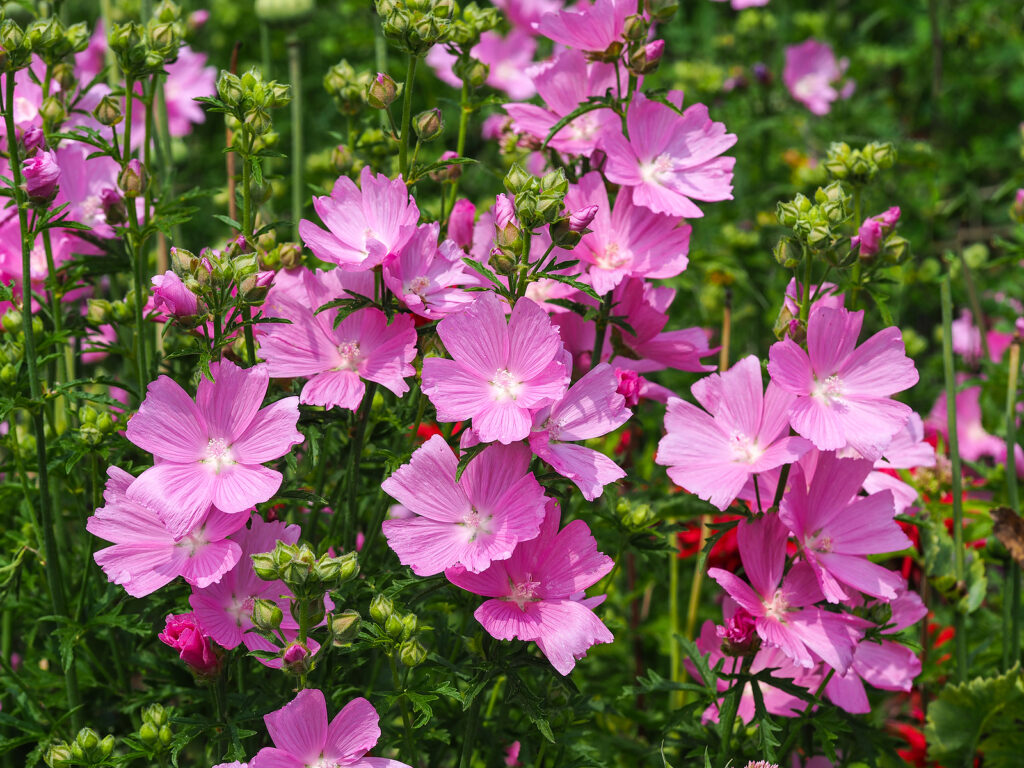Sidalcea — commonly called false mallows, miniature hollyhocks, or checkerbloom–are North American wildflowers closely related to hollyhocks (Alcea). Sidalcea bears erect racemes of five-petaled hollyhock-like flowers. Flowers come in shades of pink, purple-pink, and white.
Sidalcea flowers appear above clumps to rounded to kidney-shaped leaves. Sidalcea is suitable for growing in a mixed or herbaceous border. Sidalcea are good cut flowers.
The Sidalcea genus includes about 20 species of annual and perennials. Some are rhizomatous.

Get to know Sidalcea
- Plant type: Perennial.
- Growing zones and range: Zones 5 to 8.
- Hardiness: Hardy to Zone 5
- Height and width: 2 to 3 feet (1m), tall and nearly as wide depending on the variety.
- Foliage: Leaves are rounded and usually lobed or divided in a palmate fashion.
- Flowers: Erect racemes of silky five-petaled, hollyhock-like flowers; spikelike blooms come in shades of pink, purple-pink, or white.
- Bloom time: Summer; they will bloom long into the fall if kept cut.
- Uses: Borders or natural gardens.
- Garden companions: ‘Veitch’s Blue’ small globe thistle (Echinops ritro ‘Veitch’s Blue’)
- Common name: False mallow, wild hollyhock, cherckerbloom.
- Botanical name: Sidalcea
- Family name: Malvaceae.
- Origin: Woodlands, grasslands, and streamsides in West and Central North America
Where to plant Sidalcea
- Plant Sidalcea in sun or light shade.
- A spot with shade during the hottest part of the day is the best in the South, and Sidalcea does not tolerate heat and humidity well.
- Plant Sidalcea in moderately fertile, well-drained soil.
- Sidalcea does not do well in areas with very hot, humid summers.
When to plant Sidalcea
- Sow seed in containers in a cold frame in autumn or spring
- Set container-grown plants in the garden in spring.
Planting and spacing Sidalcea
- Space Sidalcea 2 to 3 feet (1m) apart depending on the variety.
- Sow seed 1/8 inch deep in evenly prepared soil.

How to water and feed Sidalcea
- Give Sidalcea regular water.
- Fertilize Sidalcea with an all-purpose organic fertilizer in spring.
How to care for Sidalcea
- Cut Sidalcea flowering stems back hard after the flowers fade to encourage compact growth and a second flush of blooms, as well as to curtail self-seeding.
- Dig and divide Sidalcea clumps in spring or fall if they die out in the center or outgrow their space, or for propagation.
Sidalcea pests and diseases
- Sidalcea can develop leaf spot or rust.
- Sidalcea is susceptible to attack by aphids or mites.
Sidalcea propagation
- Propagate named Sidalcea cultivars by division.
- Divide Sidalcea clumps every few years.
Sidalcea varieties to grow
- Sidalcea candida, Wild hollyhock, is one of the hardiest, with racemes of small, white, 1 inch (2.5cm) wide flowers. To 3 feet (.9m) tall.
- S. malviflora, Checkerbloom, has 2 inches (5.1cm) wide flowers in shades of pink or lavender-pink that bloom from early to midsummer; grows to 4 feet (1.2m) tall; most available cultivars are hybrids between this species and S. candida. Zones 5 to 8. Cultivars include ‘Brilliant’ bears red flowers; ‘Elsie Heugh’, a hybrid, has large, purple-pink, fringed petals. 3 feet (.9m); ‘Loveliness’, bears shell pink flowers; ‘Party Girl’, another hybrid, produces 1.5 inch (3.8cm) wide pink flowers over a long season. 2-4 feet (.6-1.2m) tall.



